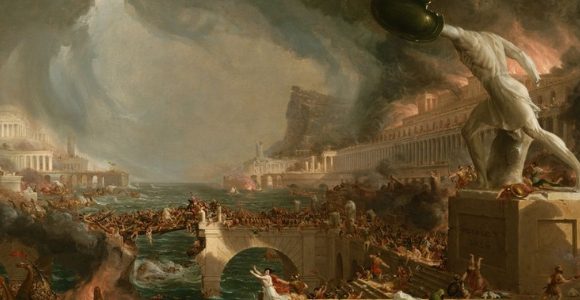Welcome readers! Please subscribe through the buttons at the right if you enjoy this post.

This week we’re continuing the series we began last week on the self-affirming, nonviolent resistance of Jesus.
In this second part, we’ll consider the shift from what Christians originally taught about nonviolence (see A Primer on Self Affirming, Nonviolence (Part 1), and what they began to teach after their social location changed when Christianity became the official religion of the Roman Empire. Later in the series, I will critique the Church Fathers’ self-sacrificial nonviolence and compare it to what I believe is Jesus’ self-affirming nonviolence. For now, I want you to note the contrast between early Christian nonviolence and the later use of violence, not as a periodic exception to Jesus’ teaching, but as the preferred method of converting non-Christians. Let’s again read from Christian teachers writing before the change:
“We [Christians] no longer take up sword against nation, nor do we learn war any more, but we have become the children of peace.” — Origin
“And shall the son of peace take part in the battle when it does not become him even to sue at law? And shall he apply the chain, and the prison, and the torture, and the punishment, who is not the avenger even of his own wrongs?” — Tertullian
“Anyone who has the power of the sword, or who is a civil magistrate wearing the purple, should desist or he should be rejected.”—Hippolytus
Hippolytus recommended that the Church excommunicate those who enlisted in the military or took a political office where they were responsible for wielding Rome’s sword.
“Rather, it is better to suffer wrong than to inflict it. We would rather shed our own blood than stain our hands and our conscience with that of another.” —Arnobius
“It makes no difference whether you put a man to death by word, or rather by the sword, since it is the act of putting to death itself which is prohibited.”—Arnobius
Again, with “by word,” Arnobius, like Hippolytus above, is referring to holding a political office where one commands state violence.
“When God forbids killing, he doesn’t just ban murder (some translations read ‘brigandage’), which is not permitted under the law even; He is also recommending us not to do certain things which are treated as lawful among men…whether you kill a man with a sword or a word makes no difference, since killing itself is banned.”—Lactantius, the tutor of Emperor Constantine’s son.
“…no exceptions at all ought to be made to the rule that it is always wrong to kill a man, whom God has wished to be regarded as a sacrosanct creature.”—Lactantius
Yet about a hundred years after Rome embraced the Christian religion, it was illegal not to be a Christian (there was an exception for Jews), and you could not serve in the military unless you were a Christian: You were not trusted as loyal unless you were a Christian.
How did Christianity get to that point?
On October 28, 312, Constantine was engaged in the Battle of the Milvian Bridge against his rival, Roman Emperor Maxentius. Lactantius recounts that, on the evening of October 27, just prior to the battle, Constantine had had a vision of the Christian God promising victory if his soldiers daubed the sign of the cross on their shields. (The details of the vision differ among sources reporting it. Lactantius reports that the vision promised victory if Constantine would delineate “the heavenly sign [‘the letter X, with a perpendicular line drawn through it and turned round thus at the top, being the cipher of CHRIST’] on the shields of his soldiers” (On the Deaths of the Persecutors, Chap. 44). Eusebius also reports that the sign God instructed them to use on their shields was the Chi Rho symbol. These reports of Constantine’s vision state that he saw a cross of light with the inscription, “through this sign you shall conquer.”
There are various theories today about these reports. Some view the vision as legend with no historical basis. Others believe Constantine made up the story after the fact: he was a great political strategist and saw a way to co-opt Christianity’s influence by uniting Christianity and Rome. Each theory is speculation, including the popular historical interpretation that the vision was genuine and that Jesus actually supported Roman conquests. What we know for sure is what happened within Christianity after this period. The Christian church’s social location changed dramatically, and what happens to individuals and communities that transition from “Have-not” to “Have” continues to amaze me.
Constantine declared Christianity a religio licita (a legal religion) through the Edict of Milan. He lavished gifts upon all Church leaders, increasing their salaries, exempting them from paying taxes, building church buildings, and funding Bible copying. Through this support, Church became centered in a building rather than in a group of people and crucifixion and gladiatorial games were abolished because of their connection with Christian victimization and trauma. The first day of the week was also declared a weekly holiday for all people and the Christian calendar absorbed pagan holidays. Pagan temples were converted into Christian churches, with statues of Roman gods replaced by statues of the Apostles and other biblical characters.
Eventually, Christianity’s becoming the official religion of the Roman empire would lead to new theological and ethical interpretations as well as new practices. Augustine, Eusebius, and others began to see Christianity’s new social location and its political power as having been handed to them by God Himself, and for the first time in history, Christians began wielding a sword in Jesus’ name. In the subsequent centuries we would get a brand new Christian norm:
“When people falsely assert that you are not allowed to take up the physical sword or fight bodily against the enemies of the Church, it is the devil trying to attack the fabric of your Order.”—Jacques de Vitry
Notice that the non-violent teachings of Jesus had come to be redefined as of the “devil.”
“Do not ever be ashamed, O Bride of Heaven, to take up the sword against heretics; for the God still lives who sanctified such action through the arms of David.”—John of Mantua
Jesus’ nonviolence would be sidelined and the example of more violent figures from the scriptures would begin to take center stage. Military leaders such as David and Joshua and others became the models of the Christian faith, and Christians, like the majority of evangelicals today, even embraced bodily torture. As Pope Innocent IV once wrote, “Bodily torture has been found the most salutary and efficient means of leading to spiritual repentance.”
Through the Church and State becoming unified, violence in defense of both became justified.
Some of the greatest minds in Christianity would come up with Biblical support for this turn. Augustine (354–430 C.E.) and, later, Aquinas (1225–1274 C.E.) made significant interpretive changes. Augustine, a bright theological mind in his time, developed and defended a “justified violence” theory for Christians based upon existing Roman and Greek thought. Christians were now encouraged to join the army and to become involved in government. Violence could be used as God’s instrument to “punish” evildoers (e.g., Romans 13:1- 7), and Augustine saw punishment as a more justifiable motive than self-defense. By 416 C.E., all Roman soldiers were required to be Christians. Up until this time, “pagan” had simply meant civilian as opposed to soldier. It came to mean non-Christian as opposed to believer.
Here is a sampling of the new Augustinian teaching:
“War is waged to serve the peace. You must, therefore, be a peacemaker even to waging war, so that by your conquest, you may lead those you subdue to the enjoyment of peace.”— Augustine
Peace as an end was separated from peace as the means. War was doing others a favor.
“What, indeed, is wrong with war? That people die who will eventually die anyway so that those who survive may be subdued in peace? A coward complains of this but it does not bother religious people.”— Augustine
“Does anyone doubt that it is preferable for people to be drawn to worship God by teaching rather than forced by fear of punishment or by pain? But because the one type of people is better, it does not mean that the others, who are not of that type, ought to be ignored.”— Augustine
Augustine taught that, yes, it’s better for people to come to worship the Christian God on their own rather than being tortured or threatened with violence, but just because some will choose the Christian God on their own doesn’t mean that we shouldn’t force others to worship. This is a complete disconnect from the teachings of Jesus. Augustine’s writing turns more and more to the Bible and to desperate attempts to find some clue in Jesus’ teachings that Jesus really didn’t mean what He taught on nonviolence and enemy love.
Augustine also exhibited dualistic Platonic (Hellenistic/Greek) thinking, which sees the body as separate from an immortal soul. This was in contrast to the more holistic philosophy of ancient Hebrew culture. With a dualist view, you could do whatever was necessary to someone’s body if it saved their soul. So killing someone could be justified if that was how you saved their soul. Augustine taught that it was acceptable to run your enemies through with the sword, as long as you did not kill them with hatred in your heart, for Jesus taught us to love our enemies.
Augustine developed and systematized a religious philosophy that justified saving souls at any cost, even by means of torture and violence. Augustine taught that the Christian should respond to torturing confessions out of others by crying “fountains of tears” for this “necessary state of affairs.” But never did he stop to consider that torture itself might be wrong. This was the origin of Christianity embracing “justified violence” in the form of the “just war” theory supported by the contemporary, Americanized, evangelical worldview.
Today we live in the wake of these changes. Christianity and its Jesus fell in the same way as all the other religions taken in by Rome. When Rome embraced the Greek gods, their appearance in pictures and statues changed. Under Roman influence, for example, Zeus (Greek) became Jupiter (Roman). But it wasn’t just their names that changed; their attributes changed too. Under Rome, the Greek gods became more warlike, and more distant, not mingling with mortals as much. They became harsher and more powerful. They came to stand for discipline, honor, strength, and violence. For instance, Hypnos, the Greek god of sleep, didn’t do much until Romanized. The Romans called him Somnus, and he liked killing people who didn’t stay alert at their jobs: if they nodded off at the wrong time, they never woke up. This same pattern took place as Rome remade the Christian God, Jesus.
If the bloody violence of Christianity’s history has taught us anything, it is that we must question the Christian theory of justified violence including redemptive violence.
Next week we will begin unpacking our first passage in this series from the Gospels. What could Jesus have meant when he taught turning the other cheek, walking the extra mile, and the stripping off of one’s under garment? Thank you for staying with us.













